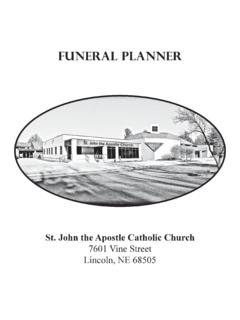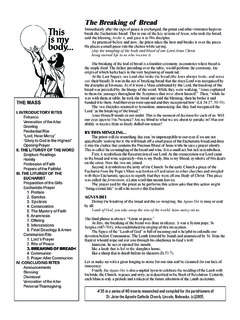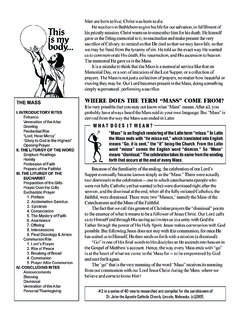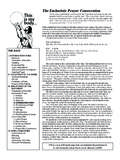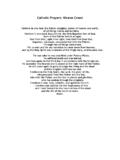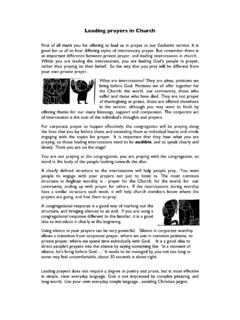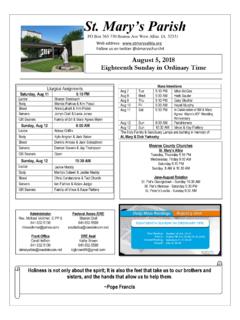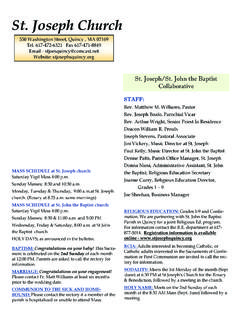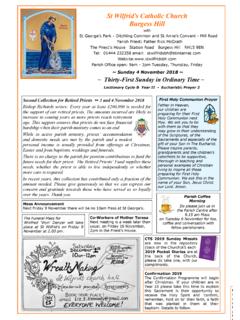Transcription of The Eucharistic Prayer: an introduction - Welcome …
1 The Eucharistic Prayer: an introduction The Eucharistic Prayer marks the summit of the Mass. This does not mean that the other parts of the Mass are less precious. They are important, too. But they find their center and climax in the Eucharistic Prayer. Eucharist means thanksgiving. As the priest recites the Eucharistic Prayer, we should concentrate all our senses on the action--the mystery--taking place on the altar. We should join the priest and the entire Church in offering to God the redeeming sacrifice of Christ on the cross, and give thanks for God's goodness and glory.
2 The Eucharistic Prayer includes not only words but also action: the Consecration. For this reason, it is the model, root, and crown of the personal prayer of every Christian. The hour of the sacrifice has come. The celebrant now moves more solemnly than before. All his motions are charged with a consciousness of their meaning as he progresses from action to action, now joining his hands, now raising them to heaven, after having made the sign of the cross over the offerings. St. John tells us what happened in the Upper Room after the meal.
3 Our Lord spoke; at first, he was interrupted by three of His apostles, but after that his hearers did not think of questioning him anymore. The Savior's discourse moved them deeply. Jesus alone spoke, THE MASS the disciples listened; they would listen to him forever. Before long, Jesus was speaking to them no longer, he was addressing the Father. They all held their breath. Jesus prayed. Isn't this situation almost exactly like that which is reproduced in the Mass? Only the I. INTRODUCTORY RITES.
4 Priest proclaims the Eucharistic Prayer by virtue of his ordination. We have heard the Entrance Lord's teaching; we have prayed aloud together, beseeching his mediation. Now the priest Veneration of the Altar speaks in persona Christi. All things considered, it would be better that no other human Greeting voice should make itself heard: Jesus is going to pray with us and for us. Penitential Rite In this prayer, we announce to the world the death and resurrection of the Lord. This is Lord, Have Mercy the paschal message that transformss us interiorly, turning us into heralds of the Good News.
5 Glory to God in the Highest . Opening Prayer VARIETY OF Eucharistic PRAYERS. II. THE LITURGY OF THE WORD In the Roman rite, the first part of the Eucharistic Prayer, known as the Preface, has Scripture Readings acquired many different texts in the course of the centuries. There were twenty Prefaces in Homily the missal at the time of Pope John XXIII. Profession of Faith The second part, known as the Canon, assumed an unchanging form. By contrast, the Oriental Prayers of the Faithful liturgies have admitted a certain variety in their Anaphoras.
6 After the Second Vatican Council, Pope III. THE LITURGY OF THE Paul VI added three more Eucharistic Prayers, keeping the very venerable Roman Canon. EUCHARIST The Roman Canon is called Roman because it originated in Rome at the end of the Preparation of the Gifts fourth century. It developed its present form during the pontificate of Gregory the Great in Eucharistic PRAYER< the seventh century and has had no significant changes since then. 1. Preface It consists of fifteen prayers often described as tiles in a mosaic.
7 We may look at all 2. Acclamation Sanctus fifteen and see their total effect, or we may go line by line and enjoy each prayer. 3. Epiclesis This Eucharistic Prayer may be used any day. It is particularly fitting on days when 4. Consecration there are special texts for the prayers In union with the whole Church .. and the prayer 5. The Mystery of Faith Father, accept this offering.. 6. Anamnesis The Second Eucharistic Prayer is the most ancient Anaphora. It follows closely the 7. Offering Anaphora of Saint Hippolytus, written at about the year 215.
8 It is vigorous and clear, and it has a solid biblical and theological background. Its features make it particularly suitable 8. Intercessions for weekdays. 9. Final Doxology & Amen The Third Eucharistic Prayer is rich with overtones of ancient Alexandrian, Byzantine, Communion Rite and Maronite Anaphoras. It expresses the doctrine of the Eucharist as the sacrifice of Christ 1. Lord's Prayer in an especially clear way. It gives prominence to the Holy Spirit, naming him four times. Its 2. Rite of Peace use is particularly suited to Sundays and holy days.
9 It may be said with any Preface. 3. Breaking of Bread The Fourth Eucharistic Prayer provides a fuller summary of the history of salvation. It 4. Communion borrows some elements from the Eastern liturgies, and even from the liturgy of the 5. Prayer After Communion synagogue. It is a profoundly biblical prayer which recounts the main events in the IV. CONCLUDING RITES history of salvation and links this history to its center: Christ. This Eucharistic Prayer has Announcements a fixed Preface; therefore, it cannot be used when a Mass has its own proper Preface.
10 Blessing There are other Eucharistic Prayers for special occasions: three Eucharistic Prayers Dismissal for Masses of children, two for Masses of reconciliation, and the so-called Eucharistic Veneration of the Altar Prayer of the Swiss Synod for Masses with some ecclesial character. Personal Thanksgiving #24 in a series of 40 inserts researched and compiled for the parishioners of St. John the Apostle Catholic Church, Lincoln, Nebraska. (c)2005.
